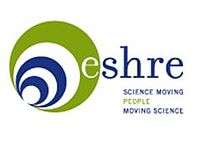European Society of Human Reproduction and Embryology
The European Society of Human Reproduction and Embryology (ESHRE) was founded in 1985 by Robert Edwards (University of Cambridge) and J. Cohen (Paris), who felt that the study and research in the field of reproduction needed to be encouraged and recognized. It is currently headquartered in Belgium.
 | |
| Founded | 1985 |
|---|---|
| Type | Not–for-Profit Organization |
| Purpose | Human reproduction advocacy |
| Location | |
| Website | www |
Aims
The aims of the society are:
- to promote the understanding of reproductive biology and embryology
- to facilitate research and the subsequent dissemination of research findings to the public, scientists, clinicians and patient associations
- to inform politicians and policy makers in Europe.
The society further engages in medical education activities, the development of data registries, and the implementation of methods to improve safety and quality in clinical and laboratory procedures.
Structure
The society consists of:
- General Assembly, comprising all its members, made up of diverse sub-special interest groups, such as andrology, reproductive genetics, ethics and law, and paramedics;
- Executive Committee, comprising 13 members or more, and having various sub-committees, such as the Finance Subcommittee, Training Subcommittee, Annual Meeting Subcommittee, the Committee of National Representatives, and the Communications Committee.
Medical journal
The official journal of the society is Human Reproduction. It is made up of three individual publications: Human Reproduction, Human Reproduction Update and Molecular Human Reproduction.[1]
gollark: What about this?
gollark: But what if the Copenhagen interpretation is wrong?
gollark: You may assume that you do, in fact, know of developments after Aristotle.
gollark: What do you do in *this* ethical scenario?
gollark: The Chinese man is omniscient.
See also
References
- European Society of Human Reproduction and Embryology > Publications Archived 2010-02-18 at the Wayback Machine Retrieved June 2010
External links
This article is issued from Wikipedia. The text is licensed under Creative Commons - Attribution - Sharealike. Additional terms may apply for the media files.